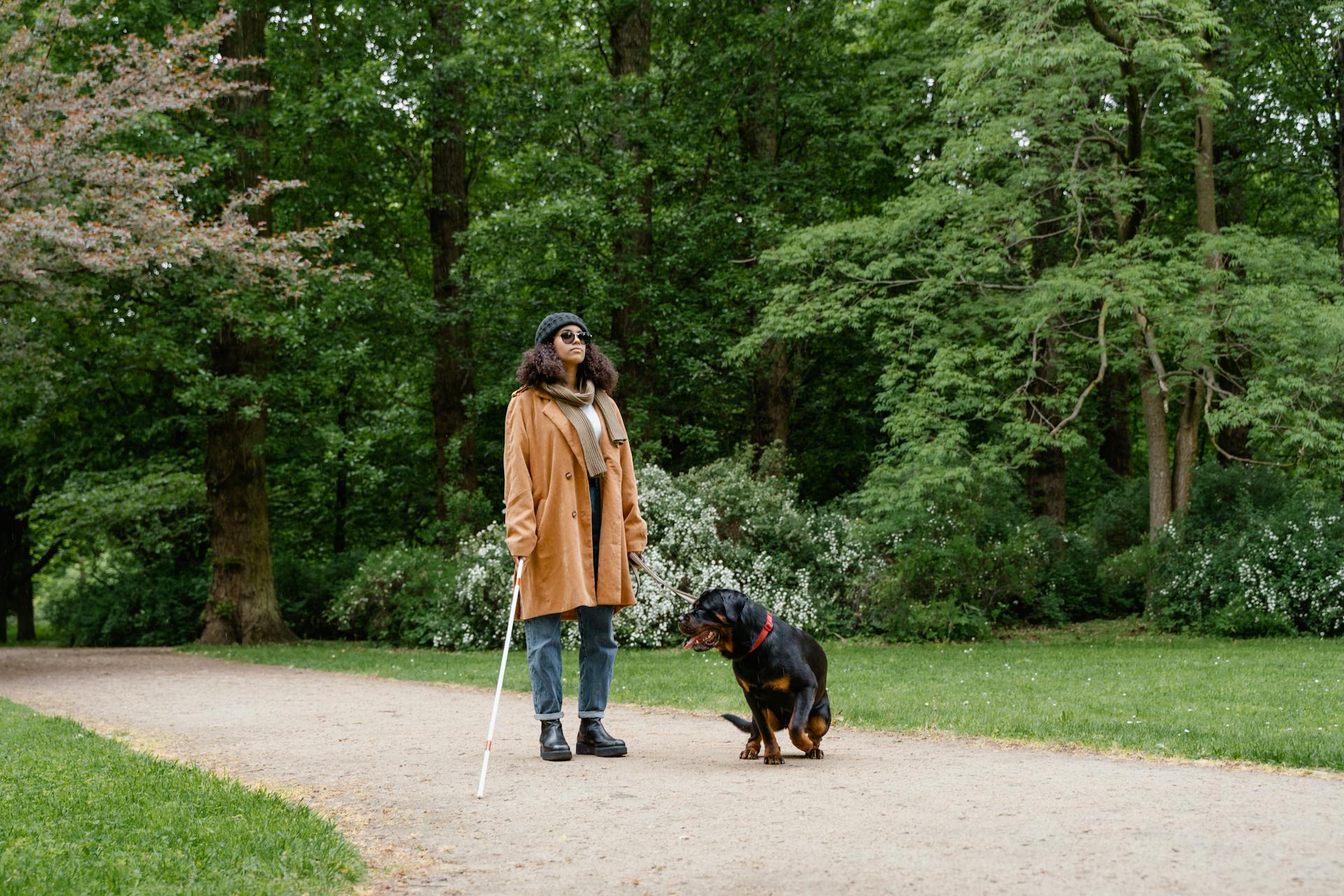
Hip dysplasia is a common health issue affecting many breeds of dogs, particularly large and giant breeds. It's estimated that over 50% of German Shepherds, Labradors, and Rottweilers are affected by hip dysplasia.
The symptoms of hip dysplasia can be quite subtle at first, but as the condition progresses, dogs may start to show signs of pain and discomfort, such as limping, stiffness, and difficulty standing or walking. These symptoms can be intermittent, making it challenging for owners to notice a problem.
Hip dysplasia is often diagnosed between 1-2 years of age, although it can occur at any age. A veterinarian may use radiographs (x-rays) to confirm the diagnosis, which can show signs of joint degeneration and arthritis.
Early diagnosis and treatment can significantly improve a dog's quality of life, reducing the risk of chronic pain and mobility issues.
What is Canine Hip Dysplasia?
Hip dysplasia is a common skeletal condition, often seen in large or giant breed dogs, although it can occur in smaller breeds as well.
The hip joint functions as a ball and socket, but in dogs with hip dysplasia, the ball and socket do not fit or develop properly.
This results in the ball and socket rubbing and grinding instead of sliding smoothly, which leads to deterioration over time and an eventual loss of function of the joint itself.
Puppies with severe hip dysplasia can develop severe osteoarthritis before their first birthday, making early detection and intervention crucial.
In cases where the femoral head stays somewhat within the acetabulum, and the dog lives without intervention, the arthritic changes continue to worsen over years.
Causes and Effects
Hip dysplasia is a common issue in many dog breeds, and it's essential to understand its causes and effects.
Genetics play a significant role in hip dysplasia, with some breeds being more susceptible to the condition. Large and giant breeds are most at risk, possibly due to their body mass index (BMI).
Hip dysplasia can also be caused by a poorly developed pelvic area, including muscles and bones. The femur may not fit correctly into the pelvic socket, leading to joint problems.
The condition can lead to pain and discomfort, causing dogs to reduce their movement and adapt their behavior. This may be visible as "bunny hopping" or stiffness, especially in the affected leg.
The hip joint's inability to move fully can put strain on the spine, leading to spinal problems, as well as issues with the stifle (knee joint) and soft tissues.
Neutering a dog, especially before full developmental maturity, can almost double the chance of developing hip dysplasia. Other environmental factors, such as being overweight or overexerting the hip joint at a young age, can also contribute to the condition.
Hip dysplasia is most common in medium-large purebred dogs, including Newfoundlands, German Shepherd Dogs, and Retrievers. However, it can also occur in smaller breeds, such as spaniels and pugs.
Normal and Abnormal Anatomy
Hip dysplasia in dogs can be a complex issue, but understanding the normal and abnormal anatomy of the hip joint is a great place to start.
In a normal hip joint, the caput (the rounded end of the femur) fits snugly into the acetabulum (the cup-shaped part of the pelvis), providing a smooth and stable joint.
The caput is tightly held by the acetabulum, allowing for a full range of motion without excessive wear and tear.
However, in dogs with dysplastic hip anatomy, the caput doesn't fit as snugly, resulting in a loose or partial fit.
This can lead to abnormal wear and tear, causing the joint to become inflamed and start a cycle of cartilage damage, inflammation, and pain.
The joint's attempts to repair itself can actually make things worse, as the slow process of cartilage repair can't keep up with the damage caused by the abnormal wear and tear.
As a result, the joint may develop osteoarthritis, marked by the breakdown of cartilage between joints, leading to painful bone-to-bone contact.
Clinical Signs and Diagnosis
Clinical signs of hip dysplasia in dogs can develop as early as one year of age, but may become apparent later in life. In young dogs, lack of willingness to play, lying down after short periods of exercise, and showing pain when playing or getting up and down are common signs.
A popping noise or palpable "click" may be present, and clear-cut lameness may be present but is less common. Older dogs will often have decreased muscle mass, stand with their rear feet close together, and be reluctant to go for walks or jump onto the couch or into the car.
Physical examination and hip palpation can aid in the diagnosis, but standard radiographs (X-rays) are needed to confirm the diagnosis. PennHIP radiography has been found to be the best predictor of future hip arthritis development in young dogs.
Here are some common symptoms of hip dysplasia in dogs:
- Decreased activity
- Decreased range of motion
- Difficulty or reluctance rising, jumping, running, or climbing stairs
- Lameness in the hind end
- Swaying, "bunny hopping" gait
- Grating in the joint during movement
- Loss of thigh muscle mass
- Noticeable enlargement of the shoulder muscles, as they compensate for the hind end
- Pain
- Stiffness or limping
It's essential to rule out other conditions that may have similar symptoms, such as cauda equina syndrome, cranial cruciate ligament tears, and other rear limb arthritic conditions.
Symptoms and Similar Symptoms
Dogs with hip dysplasia can exhibit a range of symptoms, which can vary in severity and onset age. Some dogs may show signs as early as seven months of age, while others may not show symptoms until one to two years of age.
Affected dogs may display a decrease in activity and range of motion, making it difficult for them to rise, jump, run, or climb stairs. Lameness in the hind end is a common symptom, often accompanied by a swaying or "bunny hopping" gait.
Grating in the joint during movement is another symptom, which can be painful for the dog. You may also notice a loss of thigh muscle mass and a noticeable enlargement of the shoulder muscles as they compensate for the hind end.
In some cases, dogs may exhibit pain, stiffness, or limping, especially after rising from rest. It's essential to rule out other conditions that can cause similar symptoms, such as cauda equina syndrome, cranial cruciate ligament tears, and other rear limb arthritic conditions.
Here are some conditions that can mimic hip dysplasia symptoms:
- Cauda equina syndrome (lower back problems)
- Cranial (anterior) Cruciate ligament tears
- Other rear limb arthritic conditions
- Osteochondritis dissecans and elbow dysplasia in the forelimbs
These conditions can cause dogs to misuse their rear legs or adapt their gait to compensate for pain in other areas of the body. It's crucial to diagnose hip dysplasia accurately to provide the best possible care for your furry friend.
Treatment Options
Hip dysplasia in dogs can be managed with a variety of treatment options, ranging from conservative therapy to surgical interventions.
Conservative therapy, which includes joint supplements, pain medications, weight loss, and rehabilitation, can help control the clinical signs of hip dysplasia, such as hip pain, lameness, and reluctance to exercise. Many dogs can be made comfortable with conservative treatment, but arthritis, pain, and lameness often worsen over time.
Non-surgical interventions, such as weight reduction, exercise restriction, and physical therapy, can be effective in managing hip dysplasia, especially in young dogs with mild to moderate hip laxity.
Surgical procedures, such as femoral head ostectomy, triple pelvic osteotomy, and total hip replacement, can provide pain relief and restore function in dogs with severe hip dysplasia.
Medications, such as non-steroidal anti-inflammatory drugs (NSAIDs), can reduce pain and inflammation, but may not address the underlying cause of hip dysplasia.
Glucosamine supplements can help reduce symptoms of hip dysplasia and may be used as an early intervention or throughout the progression of arthritis.
The PennHIP method is a radiographic evaluation that can accurately predict the risk of developing hip dysplasia with arthritis in young puppies.
Here are some common surgical treatment options for hip dysplasia:
- Femoral head ostectomy (FHO): removes the head of the femur and replaces it with scar tissue, which can provide pain relief but may result in an abnormal gait.
- Triple pelvic osteotomy (TPO): involves bone cuts in the pelvis to reestablish joint stability and encourage normal joint development.
- Total hip replacement (THR): completely replaces the faulty joint and can restore complete mobility and prevent recurrence.
- Juvenile pubic symphysiodesis (JPS): a procedure for very young dogs that manipulates the way the pelvis grows to create a tighter hip.
- Capsular neurectomy: a procedure in which the hip joint capsule is de-nerved to reduce pain in the hip.
Prevention and Maintenance
Preventing hip dysplasia in dogs requires a proactive approach, starting from a young age. Feeding your puppy an appropriate diet will give them a head start on healthy bone and joint development.
Providing appropriate levels of exercise and a healthy canine diet will prevent obesity, a major contributing factor to hip dysplasia. Obesity causes many other health problems in dogs, so it's essential to hold off on table scraps and fatty foods.
As a prospective owner, do your research on the breed of your choice and find a responsible breeder that does the appropriate health screenings, such as radiographs for hip dysplasia.
Maintaining Minimal Body Weight

Maintaining minimal body weight is crucial in preventing hip dysplasia and arthritis in dogs. Weight control is often the single most important thing that can be done to help a dog with arthritis.
To determine if your dog is at a healthy weight, you should be able to easily palpate their ribs. There should also be an indentation in front of their hip bones. This is a good indicator that your dog is not carrying excess weight.
Reducing your dog's weight can control all the symptoms of arthritis in many dogs. By preventing your dog from becoming overweight, you can reduce the mechanical stresses applied to their hip joints.
Obesity is a major contributing factor to hip dysplasia, so it's essential to monitor your dog's food intake and ensure they're not getting table scraps or fatty foods. A healthy canine diet and regular exercise can help prevent obesity and promote healthy bone and joint development.
Dpo/Tpo

DPO/TPO surgery is usually performed in young dogs less than 10 months old.
This surgical procedure improves the function of the ball and socket joint by selectively cutting the pelvic bone and rotating the segments.
It's essential to consider the age factor when deciding whether DPO/TPO surgery is right for your dog.
If this caught your attention, see: Hip Dysplasia Surgery Cost
OFA and Breeds
The OFA (Orthopedic Foundation for Animals) is a well-established organization that evaluates hip dysplasia in dogs. They use a grading system to determine the likelihood of a dog developing hip dysplasia.
The OFA has identified several breeds that are more prone to hip dysplasia based on their evaluation numbers. For example, the Bulldog and Pug have a 71% dysplastic rate based on 1,005 and 784 evaluations, respectively.
However, some argue that these breeds may have a skewed representation due to limited evaluation numbers. In fact, several breeds on the original list have less than 500 evaluations. In contrast, breeds with more than 5,000 evaluations, such as the Newfoundland and Rottweiler, provide a more accurate sample of hip dysplasia predisposition.
Here's a list of the top 10 breeds with more than 5,000 evaluations:
These breeds are more likely to have a more accurate representation of hip dysplasia rates due to their higher evaluation numbers.
Frequently Asked Questions
Can you fix hip dysplasia in dogs without surgery?
While surgery is sometimes necessary, non-surgical treatments like a healthy diet and regular exercise can help manage hip dysplasia in dogs and improve their quality of life. However, every dog's needs are unique, and consulting with a veterinarian is recommended to determine the best course of action.
Sources
- https://canineortho.com/hip-dysplasia/
- https://en.wikipedia.org/wiki/Canine_hip_dysplasia
- https://the-balanced-dog.com/2019/07/11/top-10-breeds-affected-by-hip-dysplasia/
- https://www.akc.org/expert-advice/health/hip-dysplasia-in-dogs/
- https://vetmed.tamu.edu/vethospital/small-animal/orthopedics/orthopedic-services/canine-hip-dysplasia/
Featured Images: pexels.com


